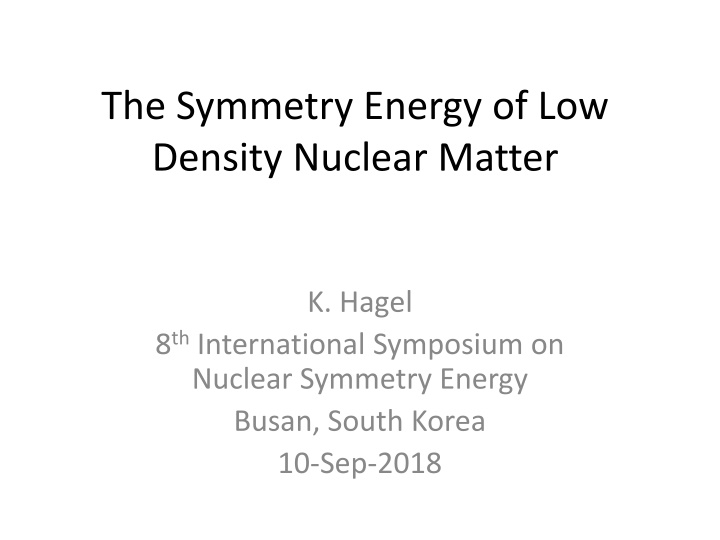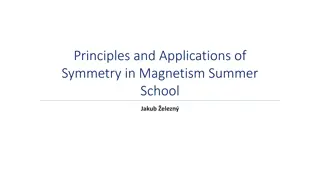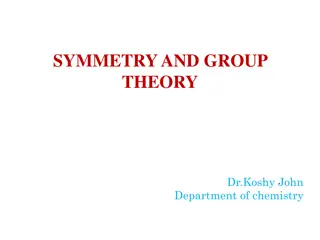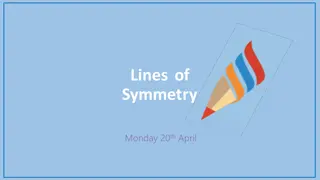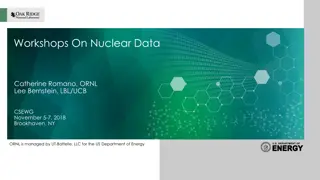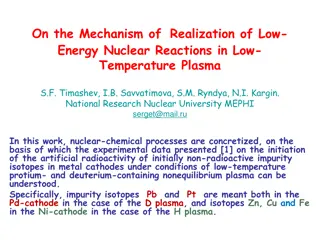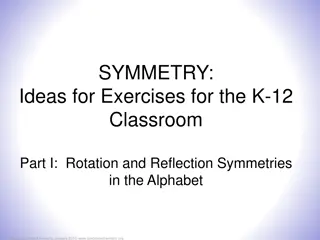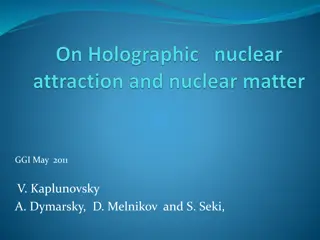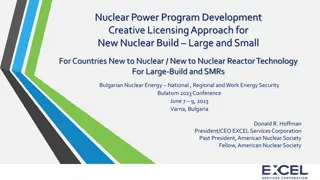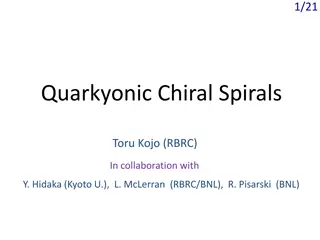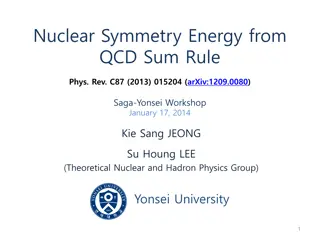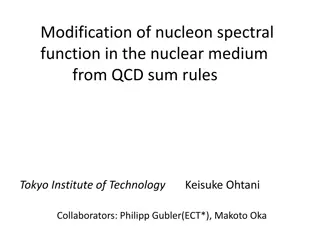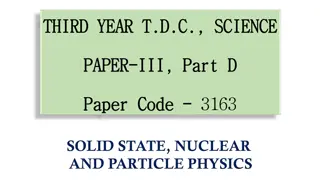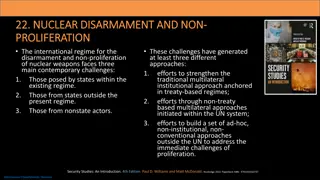Symmetry Energy in Nuclear Matter and Astrophysical Phenomena
This content delves into the intricacies of the symmetry energy of low-density nuclear matter, exploring its impact on nuclear structure, astrophysical processes, and the equation of state. It discusses the crucial role of cluster formation, the limitations of mean-field approaches, and the significance of quantum statistical models in understanding phenomena such as core-collapse supernovae. The analysis extends to experimental observations of heavy-ion collisions and femtonova interactions.
Download Presentation

Please find below an Image/Link to download the presentation.
The content on the website is provided AS IS for your information and personal use only. It may not be sold, licensed, or shared on other websites without obtaining consent from the author.If you encounter any issues during the download, it is possible that the publisher has removed the file from their server.
You are allowed to download the files provided on this website for personal or commercial use, subject to the condition that they are used lawfully. All files are the property of their respective owners.
The content on the website is provided AS IS for your information and personal use only. It may not be sold, licensed, or shared on other websites without obtaining consent from the author.
E N D
Presentation Transcript
The Symmetry Energy of Low Density Nuclear Matter K. Hagel 8thInternational Symposium on Nuclear Symmetry Energy Busan, South Korea 10-Sep-2018
Symmetry Energy Characterizes the dependence of nuclear binding energy on neutron/proton asymmetry ? ? ?,?,? = ?0?,? + ?????,? ?2+ ?(?4) =?? ?? ? =? ? ? Governs phenomenon from nuclear structure to astrophysical processes. Fundamental ingredient in the investigation of exotic nuclei, heavy-ion collisions and astrophysical phenomena. Fundamental ingredient of the nuclear EOS. Heavy-ion collisions allow the study the EOS of asymmetric matter under controlled laboratory conditions.
Dependence on Nuclear Density Normal density nuclear matter Symmetry energy results primarily from binding energies of nuclei. Bethe-Weizsacher mass formula ? ?0,0 =28-34 MeV Low density nuclear matter Change resulting from additional binding of symmetric matter due to formation of clusters. ????? =??,? 2 ?0 23 ? +??,? ? ? ?0 2
Low Density Nuclear Matter Correlations and cluster formation are essential and have to be taken into account. Cluster formation dominates structure of low density symmetric matter in low temperature limit. Cluster formation increases the symmetry energy at very low densities Important in modeling of core collapse supernovae Most of the recently used treatments do not give the correct low-density limit that is governed by cluster formation Mean-field approaches cannot describe the quantum state of matter at low densities because correlations are neglected. Skyrme interaction Relativistic mean-field (RMF) approximation Fail to give correct low temperature low density limit Correct low density limit recovered only if formation of clusters properly accounted for. Quantum Statistical models that include in-medium effects Include clusters in a virial expansion.
Crab Nebula, HST Image Supernova Mass: 4.6 1.8 M (~9.2x1030kg) V Nuclear Reaction from Heavy Ion Collision PLF IV TLF IV Source femtonova ~ vp ~vp Mass: 20-30 amu (~ 3.3x10-26 kg) V
Experiment Analysis 47 MeV/u Ar + 112,124Sn Select the most violent collisions Identify the femtonova Intermediate velocity source nucleon-nucleon collisions early in the reaction Choose light particles at 45o because moving source fits suggest that most products at that angle originate from that source. Use coalescence analysis to estimate density Temperature from Albergo model Time scale from velocity of products from intermediate velocity source tavg, fm/c vsurf, cm/ns PRC 72 (2005) 024603
Coalescence Parameters Awes et al., PRC 24, 89 (1981). ? ???(?,?) ??? ???(?,?) ??? ??(??) ??? ? ? ?? ??? ? ? ???(?,?,??) ????? ?? ? ?!?! ???(?,?,?) ???? = ??? ???? ?? ?/? Mekjian et al., PRC 17, 1051 (1978). ? ????(?,?) ? ???(?,?) ??? ????? + ? ???/? ?? ? = ??? ?? ??? 1 ?!?!?3 2? ? 13 3 4??0 2? + 1 ??0/? ? = 3
Temperatures and Densities Recall vsurf vs time calculation System starts hot and expands as it cools 47 MeV/u 40Ar + 112Sn Core collapse supernova simulation Time T. Fischer et al., ApJS 194, 39 (2011)
Equilibrium constant model predictions Models converge at lowest densities, but are significantly below data Lattimer & Swesty with K=180, 220 show best agreement with data QSM with p-dependent in-medium binding energy shifts PRL 108 (2012) 172701.
Comparison of all models together 4He Two groups of calculations n, p, calculations which predict Keq( ), but cannot predict other species. Models with n, p, d, t, 3He, Low densities All Keq( ) converge to ideal gas They are below experimental data which result from the very late stages of the reaction Models that treat all light particles are generally within error bars d t 3He Phys. Rev. C 91, 045805 (2015).
Isoscaling parameters ??.? ????= ?? ?/? ?.???????? ?? ?? = ????+?? ? ? ? =????? ?? ?? ?? ?? ? T, increase with vsurf Decrease in with vsurf Fsym extracted for light particles (liquid)
Symmetry energy S. Typel et al., Phys. Rev. C 81, 015803 (2010). Symmetry Free Energy T is changing as increases Isotherms of QS calculation that includes in-medium modifications to cluster binding energies Entropy calculation (QS approach) Symmetry energy (Esym = Fsym + T Ssym)
Comparison with QS and RMF EJPA 50 39 (2014) PRL 104 202501 (2010) QS model shows better agreement with data. Medium-dependent cluster formation necessary ingredient in theoretical models reproduce low-density dependence of the symmetry energy observed in experiments.
Summary Low Density Nuclear Matter Coalescense analysis 0.003 < ? < 0.03 is sampled Equilibrium constants Constraints on model calculations Models that treat in-medium effects fit the data better Soft EOS is suggested Density dependence of symmetry energy at low density Symmetry free energy Symmetry Energy Models that treat clusters properly (Quantum Statistical) describe data Account for in-medium effects
Outlook Explore isospin degree of freedom of different quantities on the density dependence at low densities. Light ION Guide at TAMU Cyclotron being commissioned. Use RIB with Upgraded NIMROD to explore dependencies on yp Should be able to reach 0.39 < yp < 0.46
Collaborators L. Qin, K. Hagel, R. Wada, J. B. Natowitz, S. Shlomo, A. Bonasera, G. R pke, S. Typel, Z. Chen, M. Huang, J. Wang, H. Zheng, S. Kowalski, M. Barbui, M. R. D. Rodrigues, K. Schmidt, D. Fabris, M. Lunardon, S. Moretto, G. Nebbia, S. Pesente, V. Rizzi, G. Viesti, M. Cinausero, G. Prete, T. Keutgen, Y. El Masri, Z. Majka, and Y. G. Ma,
